Characteristics of Thermal Comfort Conditions in Cold Rural Areas of China: A Case study of Stone Dwellings in a Tibetan Village
Abstract
:1. Introduction
2. Background Information
2.1. Climate Characteristics
2.2. Buildings
3. Methodology
3.1. Subjective Questionnaire
3.2. Environmental Parameter Measurements
3.3. Subjects
3.4. Thermal Comfort Model
3.4.1. PMV Index
3.4.2. Operative Temperature
3.4.3. Adaptive Predicted Mean Votes (aPMV)
4. Results and Discussion
4.1. Annual Indoor Environmental Parameters
4.2. Adaptive Behaviours
4.3. Indoor Thermal Environment
4.4. Comparative Analysis of PMV and AMV
5. Adaptive Thermal Comfort
5.1. Obtaining the Adaptive Coefficient
5.2. Thermal Comfort Zone
6. Conclusions
- In winter, indoor air temperature in residential buildings fluctuates greatly from 3.1 to 8.1 °C, and the outdoor temperatures fluctuates between −5.61 and 10.26 °C, while the indoor relative humidity ranges from 54.3% to 70.8%. The indoor temperatures were higher than the outdoor temperature during the studied period.
- The thermal neutral temperature (Tn) determined by the PMV model was almost 5 °C higher than the Tn observed based on the actual Mean Vote (AMV) model determined by the survey results. When AMV is equal to 0, the indoor thermal neutral temperature in winter was 12.92 °C, which was lower than the predicted thermal neutral temperature of 17.76 °C in this region.
- The residents maintain a unique lifestyle in terms of thermal adaptation. They wear heavy clothing (2.0 to 2.2 clo) and drink milk or buttered tea to protect themselves from the cold winter. Another two popular adaptive behaviours are blocking windows against from draughts, and increasing activity.
- It was observed that the PMV model underestimated the comfort sensations of the occupants in cold climates. Theoretical thermal comfort models have been developed that explain the deviation in the PMV and AMV plots.
- An aPMV model and adaptive coefficient was developed for winter season in cold regions of China in Tibet.
- By applying the adaptive thermal comfort model (aPMV model), the adaptive thermal comfort coefficient value of −0.32 has been obtained and validated for residential buildings in Danba.
Acknowledgments
Author Contributions
Conflicts of Interest
References
- Mahdavi, A.; Kumar, S. Implications of indoor climate control for comfort, energy and environment. Energy Build. 1996, 24, 167–177. [Google Scholar] [CrossRef]
- Gou, Z.; Lau, S.S.-Y.; Shen, J. Indoor environmental satisfaction in two LEED offices and its implications in green interior design. Indoor Built Environ. 2012, 21, 503–514. [Google Scholar] [CrossRef]
- Gou, Z.; Lau, S.S.-Y.; Chen, F. Subjective and objective evaluation of the thermal environment in a three-star green office building in China. Indoor Built Environ. 2012, 21, 412–422. [Google Scholar] [CrossRef]
- Khoshbakht, M.; Gou, Z.; Lu, Y.; Xie, X.; Zhang, J. Are green buildings more satisfactory? A review of global evidence. Early warning and assessment report series. Habitat Int. 2018, in press. [Google Scholar] [CrossRef]
- Khoshbakht, M.; Gou, Z.; Dupre, K. Energy use characteristics and benchmarking for higher education buildings. Energy Build. 2018, 164, 61–76. [Google Scholar] [CrossRef]
- Khoshbakht, M.; Gou, Z.; Dupre, K. Cost-benefit prediction of green buildings: SWOT analysis of research methods and recent applications. Procedia Eng. 2017, 180, 167–178. [Google Scholar] [CrossRef]
- Sun, X.; Gou, Z.; Lau, S.S.-Y. Cost-effectiveness of active and passive design strategies in existing building retrofits in tropical climate: Case study of a zero energy building. J. Clean. Prod. 2018, 183, 35–45. [Google Scholar] [CrossRef]
- Yao, R.; Li, B.; Liu, J. A theoretical adaptive model of thermal comfort–Adaptive Predicted Mean Vote (aPMV). Build. Environ. 2009, 44, 2089–2096. [Google Scholar] [CrossRef]
- De Dear, R.; Akimoto, T.; Arens, E.; Brager, G.; Candido, C.; Cheong, K.; Li, B.; Nishihara, N.; Sekhar, S.; Tanabe, S. Progress in thermal comfort research over the last twenty years. Indoor Air 2013, 23, 442–461. [Google Scholar] [CrossRef] [PubMed]
- Fanger, P.O. Thermal Comfort: Analysis and Applications in Environmental Engineering; Danish Technical Press: Copenhagen, Denmark, 1970. [Google Scholar]
- Alfano, F.R.A.; Olesen, B.W.; Palella, B.I. Povl Ole Fanger’s impact ten years later. Energy Build. 2017, 152, 243–249. [Google Scholar] [CrossRef]
- Xiong, Z.; Yang, K. Theoretical model of infrared radiation of dressed human body indoors. In Proceedings of the International Symposium on Photoelectronic Detection and Imaging 2007: Photoelectronic Imaging and Detection, Beijing, China, 3 March 2008; International Society for Optics and Photonics: Bellingham, WA, USA, 2008. [Google Scholar]
- ISO 8996. Ergonomics of the Thermal Environment e Determination of Metabolic Rate; International Standardization Organization: Geneva, Switzerland, 2004.
- ISO 7726. Ergonomics of the Thermal Environment—Instruments for Measuring Physical Quantities; International Standardization Organization: Geneva, Switzerland, 1998.
- ISO 10551. Ergonomics of the Thermal Environment e Assessment of the Influence of the Thermal Environment Using Subjective Judgement Scales; International Standardization Organization: Geneva, Switzerland, 1995.
- Fanger, P.O.; Toftum, J. Extension of the PMV model to non-air-conditioned buildings in warm climates. Energy Build. 2002, 34, 533–536. [Google Scholar] [CrossRef]
- Alfano, F.R.A.; Ianniello, E.; Palella, B.I. PMV–PPD and acceptability in naturally ventilated schools. Build. Environ. 2013, 67, 129–137. [Google Scholar] [CrossRef]
- Alfano, F.R.A.; Bellia, L.; Boerstra, A.; Van Dijken, F.; Ianniello, E.; Lopardo, G.; Minichiello, F.; Romagnoni, P.; da Silva, M.G. REHVA-Indoor Environment and Energy Efficiency in Schools—Part 1; REHVA: Brussels, Belgium, 2010; Volume 2010, pp. 1–121. [Google Scholar]
- Dušan, K.; Miloslav, B.; Marián, V.; Anna, V.; Martin, K.; Maros, N. Analysis of an indoor environment in year-round operation. Adv. Mater. Res. 2013, 649, 37–40. [Google Scholar]
- De Dear, R.J.; Brager, G.S.; Reardon, J.; Nicol, F. Developing an adaptive model of thermal comfort and preference/discussion. ASHRAE Trans. 1998, 104, 145. [Google Scholar]
- Humphreys, M.A.; Nicol, J.F.; Raja, I.A. Field studies of indoor thermal comfort and the progress of the adaptive approach. Adv. Build. Energy Res. 2007, 1, 55–88. [Google Scholar] [CrossRef]
- Brager, G.S.; De Dear, R.J. Thermal adaptation in the built environment: A literature review. Energy Build. 1998, 27, 83–96. [Google Scholar] [CrossRef]
- De Dear, R.J.; Brager, G.S. Thermal comfort in naturally ventilated buildings: Revisions to ASHRAE Standard 55. Energy Build. 2002, 34, 549–561. [Google Scholar] [CrossRef]
- Arif, M.; Katafygiotou, M.; Mazroei, A.; Kaushik, A.; Elsarrag, E. Impact of indoor environmental quality on occupant well-being and comfort: A review of the literature. Int. J. Sustain. Built Environ. 2016, 5, 1–11. [Google Scholar]
- Yao, R. Indoor Climate Simulation and Thermal Comfort Research. Ph.D. Thesis, Chongqing University, Chongqing, China, 1997. [Google Scholar]
- Cao, B.; Zhu, Y.; Ouyang, Q.; Zhou, X.; Huang, L. Field study of human thermal comfort and thermal adaptability during the summer and winter in Beijing. Energy Build. 2011, 43, 1051–1056. [Google Scholar] [CrossRef]
- Han, J.; Zhang, G.; Zhang, Q.; Zhang, J.; Liu, J.; Tian, L.; Zheng, C.; Hao, J.; Lin, J.; Liu, Y. Field study on occupants’ thermal comfort and residential thermal environment in a hot-humid climate of China. Build. Environ. 2007, 42, 4043–4050. [Google Scholar] [CrossRef]
- Yang, L.; Yan, H.; Xu, Y.; Lam, J.C. Residential thermal environment in cold climates at high altitudes and building energy use implications. Energy Build. 2013, 62, 139–145. [Google Scholar] [CrossRef]
- Zhang, Y.; Chen, H.; Meng, Q. Thermal comfort in buildings with split air-conditioners in hot-humid area of China. Build. Environ. 2013, 64, 213–224. [Google Scholar] [CrossRef]
- Zhang, Y.; Wang, J.; Chen, H.; Zhang, J.; Meng, Q. Thermal comfort in naturally ventilated buildings in hot-humid area of China. Build. Environ. 2010, 45, 2562–2570. [Google Scholar] [CrossRef]
- Wang, Z.J.; Wang, G.; Lian, L.-M. A field study of the thermal environment in residential buildings in Harbin. Trans. Am. Soc. Heat. Refrigerating Air Cond. Eng. 2003, 109, 350–355. [Google Scholar]
- Zou, M.; Yang, L.; Yan, H. Investigation of summer thermal comfort in village and town house in Hanzhoung. Build. Sci. Res. Sichuan 2013, 39, 341–345. [Google Scholar]
- Yan, H.; Yan, L.; Zhou, B. Field research on indoor thermal comfort of residential buildings in Jiaozuo in winter. J. HV&AC 2011, 41, 119–125. [Google Scholar]
- Yang, L.; Yang, Q.; Yan, H.; Liu, J. Investigation and Study on indoor thermal comfort of rural residential buildings in Guanzhong, Shaanxi. J. Xi’an Univ. Archit. Technol. 2011, 43, 551–556. [Google Scholar]
- Li, B.; Zheng, J.; Yao, R.; Jing, S. Indoor Thermal Environment and Human Thermal Comfort; Chongqing University Press: Chongqing, China, 2012. [Google Scholar]
- Zhou, L.; He, Y.; Li, N.; Zhang, W. Investigation on thermal comfort of rural residential buildings in winter in Xiangxi. Build. Sci. 2016, 32, 29–33. [Google Scholar]
- Wang, J.; Wang, H.; Liu, Y. The thermal comfort of the students in the primary and secondary schools in Qinghai. J. Civ. Archit. Environ. Eng. 2017, 39, 32–37. [Google Scholar]
- Li, K. Evaluation of Indoor Thermal Environment in Rural Housing in Chongqing. Ph.D. Thesis, Chongqing Univercity, Chongqing, China, 2015. [Google Scholar]
- Yang, Z.; Xu, Y.; Peng, M. Adaptability of wood wall dwellings to hot and humid climate. J. Civ. Archit. Environ. Eng. 2016, 38, 1–6. [Google Scholar]
- Zheng, W.; Yang, L.; Song, X. Climatic seasonal changes of adaptive level of human body in cold regions. J. HV AC 2015, 2015, 80–85. [Google Scholar]
- Wang, Y. Study on the Characteristics of Indoor Thermal and Wet Environment in Tibet. Ph.D. Thesis, Chongqing University, Chongqing, China, 2015. [Google Scholar]
- He, Q.; Liu, D.; Zhu, X. Test and study on the indoor thermal environment of Tibetan folk dwellings in Western Sichuan Plateau. J. Xi’an Archit. Technol. 2015, 3, 402–406. [Google Scholar]
- Ou, J.; Wang, C.; Li, Q. Investigation and measurement of the heat environment of the winter ledger in the pastoral area of Western Sichuan Plateau. Build. Sci. 2016, 6, 39–44. [Google Scholar]
- Chen, Y.; Chen, B.; Gao, M. Indoor thermal and wet environment test of a Tibetan stone dwelling in Danba during the transition season. Sichuan Archit. 2017, 37, 63–64. [Google Scholar]
- Gou, Z.; Xie, X.; Lu, Y.; Khoshbakht, M. Quality of Life (QoL) Survey in Hong Kong: Understanding the Importance of Housing Environment and Needs of Residents from Different Housing Sectors. Int. J. Environ. Res. Public Health 2018, 15, 219. [Google Scholar] [CrossRef] [PubMed]
- McCullough, E.A.; Jones, B.W.; Huck, J. A comprehensive data base for estimating clothing insulation. ASHRAE Trans. 1985, 91, 29–47. [Google Scholar]
- ASHRAE Standard 2004. Thermal Environmental Conditions for Human Occupancy; American Society of Heating, Refrigerating and Air-Conditioning Engineers: New York, NY, USA, 2004.
- Alfano, F.R.A.; Palella, B.I.; Riccio, G. The role of measurement accuracy on the thermal environment assessment by means of PMV index. Build. Environ. 2011, 46, 1361–1369. [Google Scholar] [CrossRef]
- Cao, B.; Luo, M.; Li, M.; Zhu, Y. Too cold or too warm? A winter thermal comfort study in different climate zones in China. Energy Build. 2016, 133, 469–477. [Google Scholar] [CrossRef]
- da Silva, M.C.G.; Pires, J.N.; Loureiro, A.; Pereira, L.D.; Neto, P.; Gaspar, A.; Viegas, D.X.; Soares, N.; Oliveira, M.; Costa, J. Spreadsheets for the calculation of Thermal Comfort Indices PMV and PPD. Renew. Sustain. Energy Rev. 2014, 40, 911–922. [Google Scholar]
- Alfano, F.R.A.; Palella, B.I.; Riccio, G. Notes on the Calculation of the PMV Index by Means of Apps. Energy Procedia 2016, 101, 249–256. [Google Scholar] [CrossRef]
- Fountain, M.; Huizenga, C. A Thermal Sensation Prediction Software Tool for Use by the Profession; American Society of Heating, Refrigerating and Air-Conditioning Engineers: New York, NY, USA, 1997. [Google Scholar]
- International Organization for Standardization. Ergonomics of the Thermal Environment: Analytical Determination and Interpretation of Thermal Comfort Using Calculation of the PMV and PPD Indices and Local Thermal Comfort Criteria; International Organization for Standardization: Geneva, Switzerland, 2005. [Google Scholar]
- Yu, W.; Li, B.; Yao, R.; Wang, D.; Li, K. A study of thermal comfort in residential buildings on the Tibetan Plateau, China. Build. Environ. 2017, 119, 71–86. [Google Scholar] [CrossRef]
- Kim, J.T.; Lim, J.H.; Cho, S.H.; Yun, G.Y. Development of the adaptive PMV model for improving prediction performances. Energy Build. 2015, 98, 100–105. [Google Scholar] [CrossRef]
- Nicol, J.F.; Humphreys, M.A. Adaptive thermal comfort and sustainable thermal standards for buildings. Energy Build. 2002, 34, 563–572. [Google Scholar] [CrossRef]
- Xu, W.; Chen, X.; Zhao, J. An adaptive Predicted Mean Vote (aPMV) model in office. In Proceedings of the Mechanic Automation and Control Engineering (MACE), Wuhan, China, 26–28 June 2010. [Google Scholar]
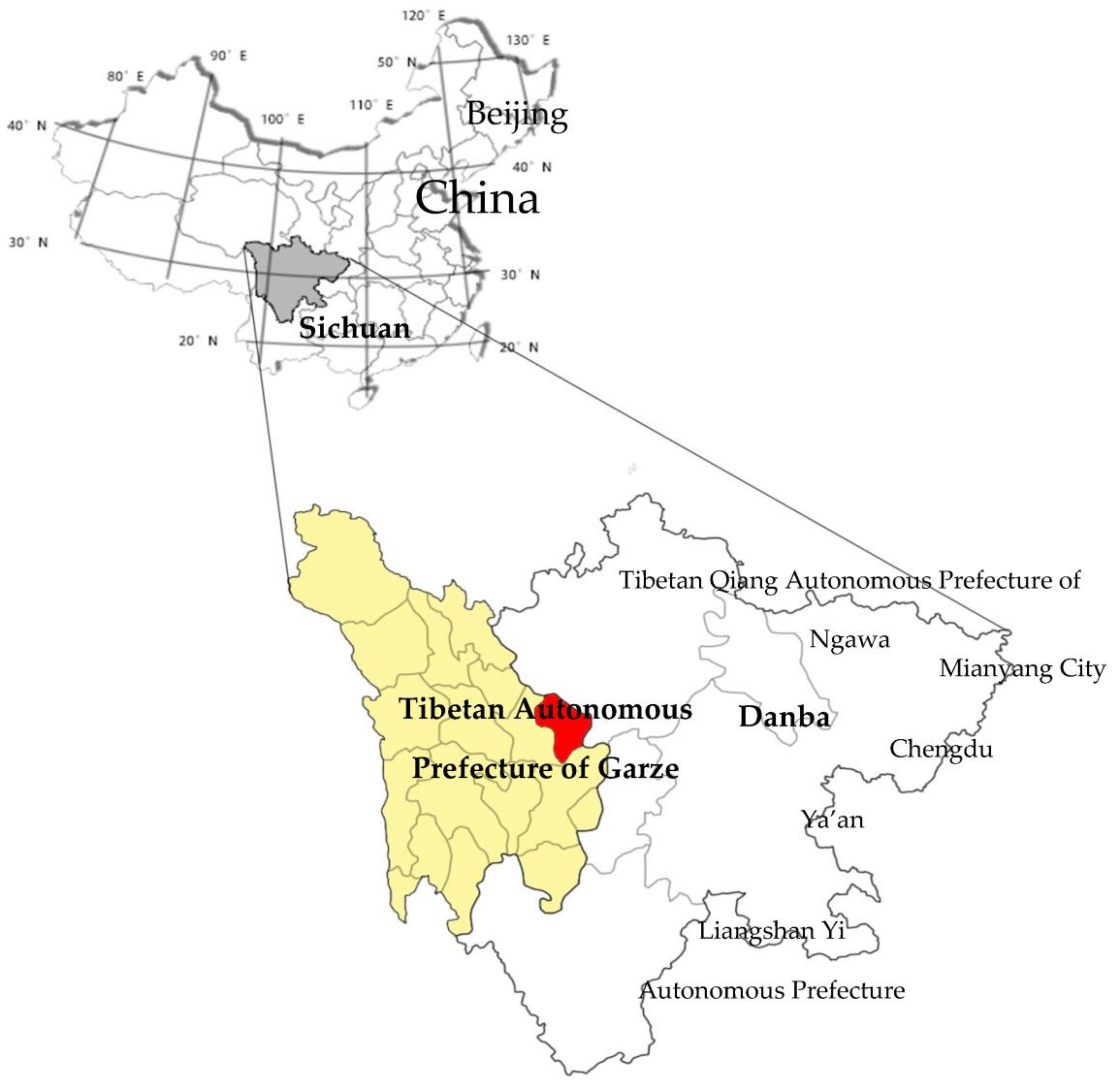

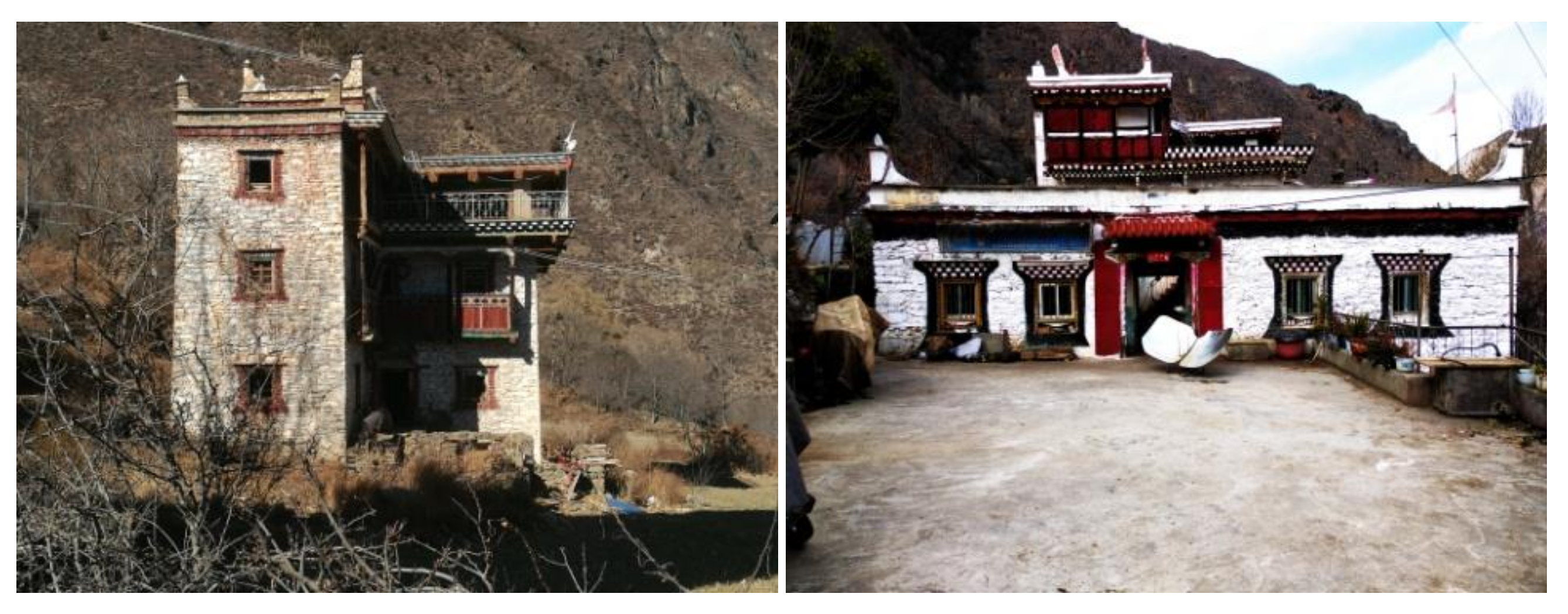
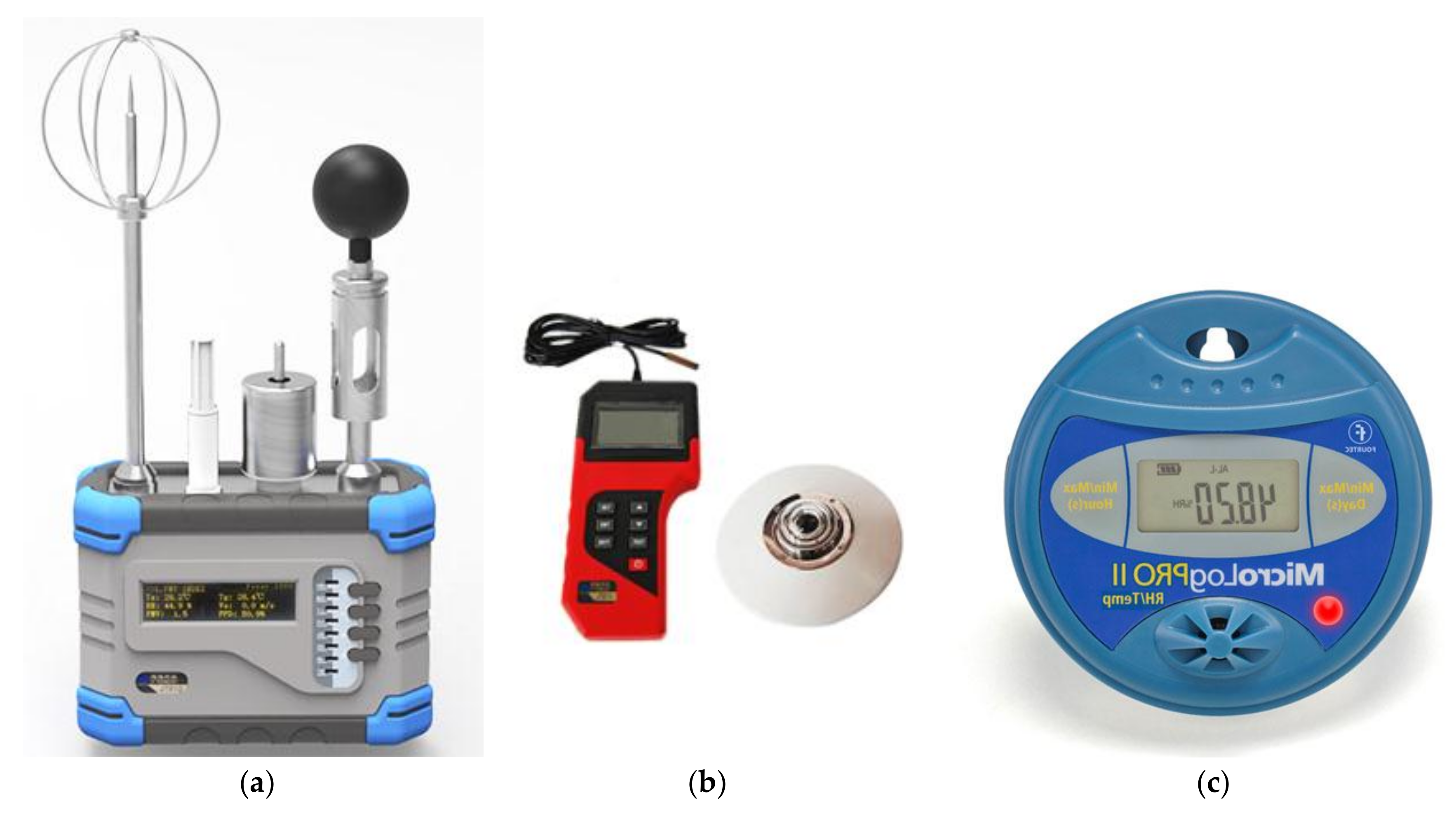

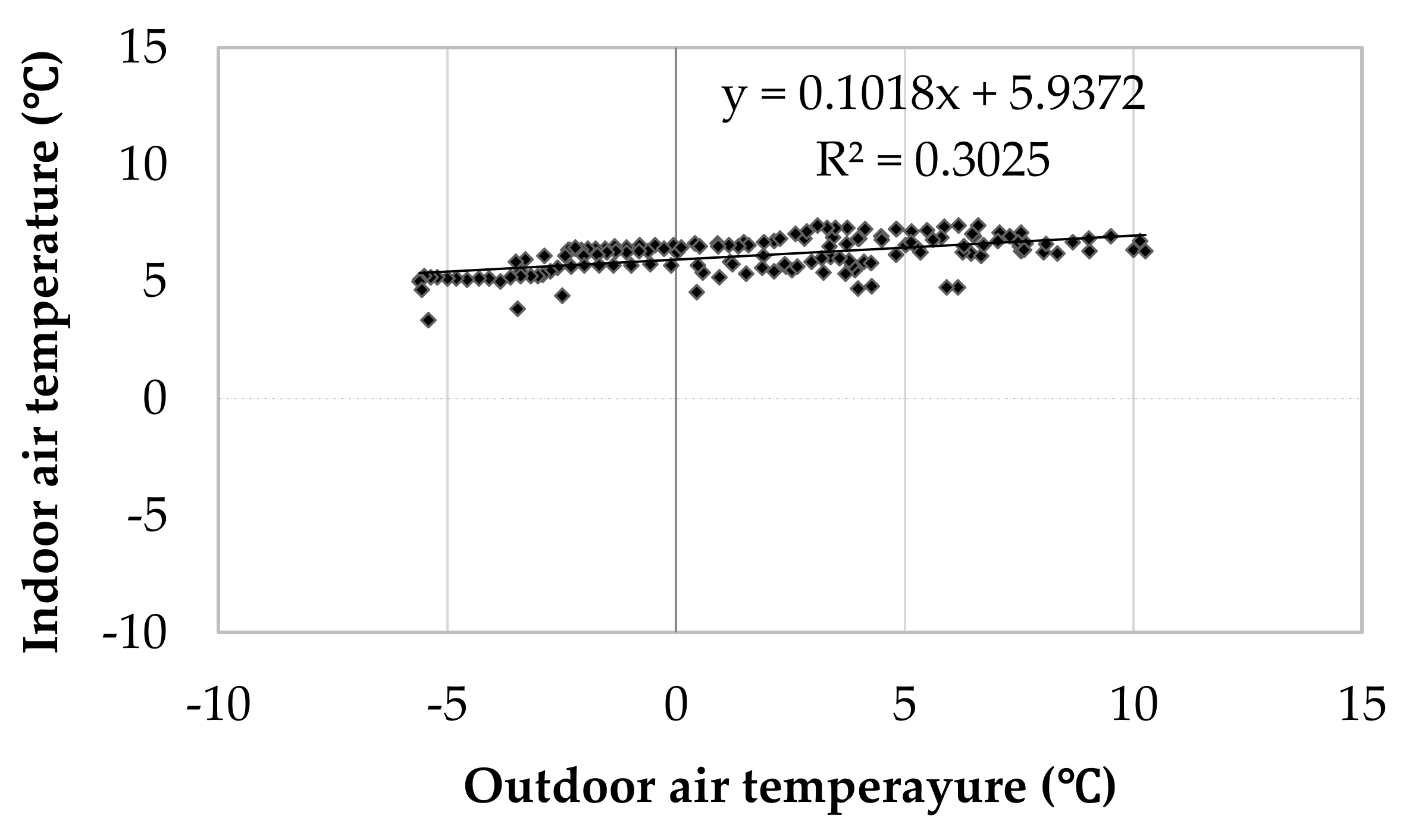

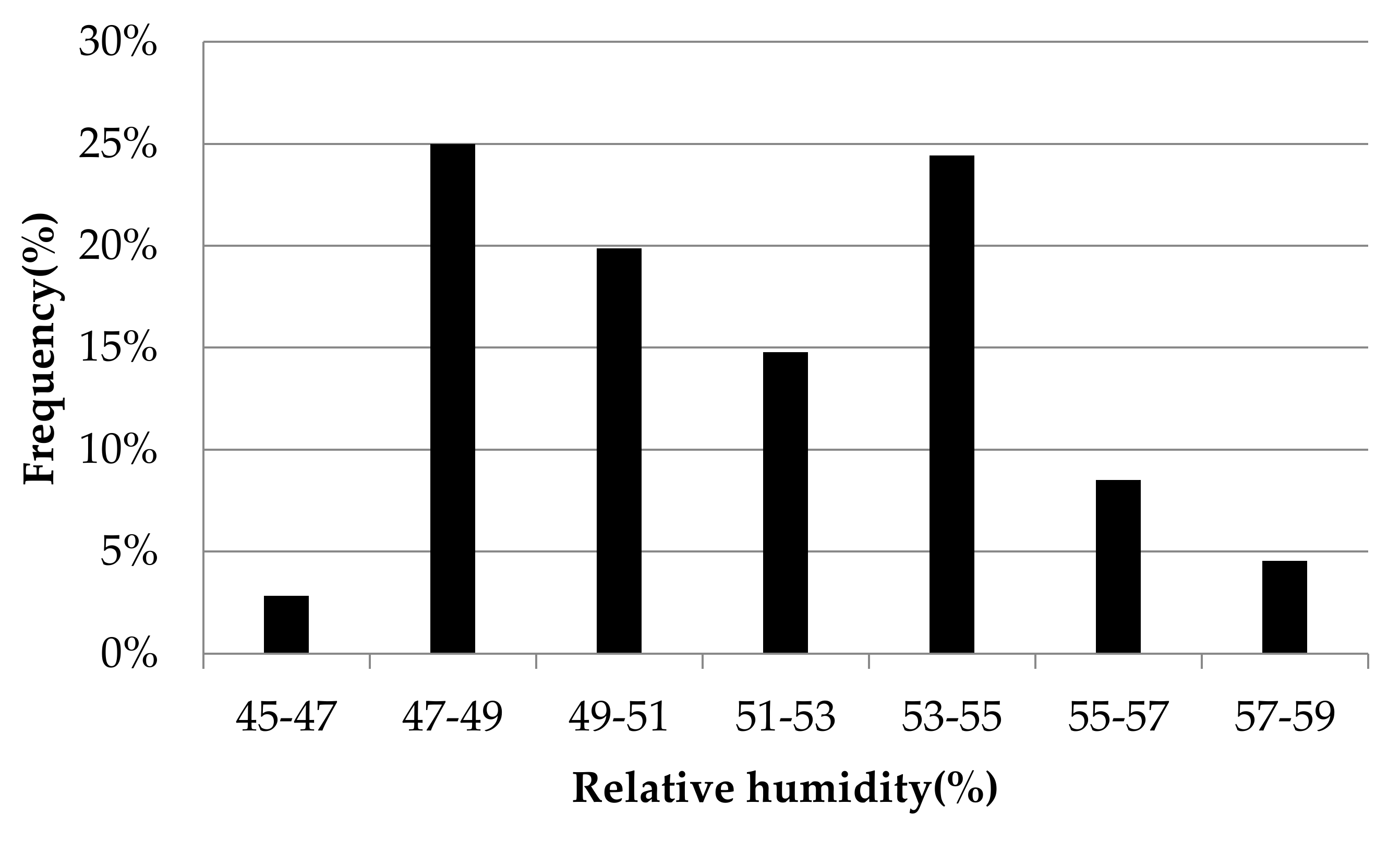
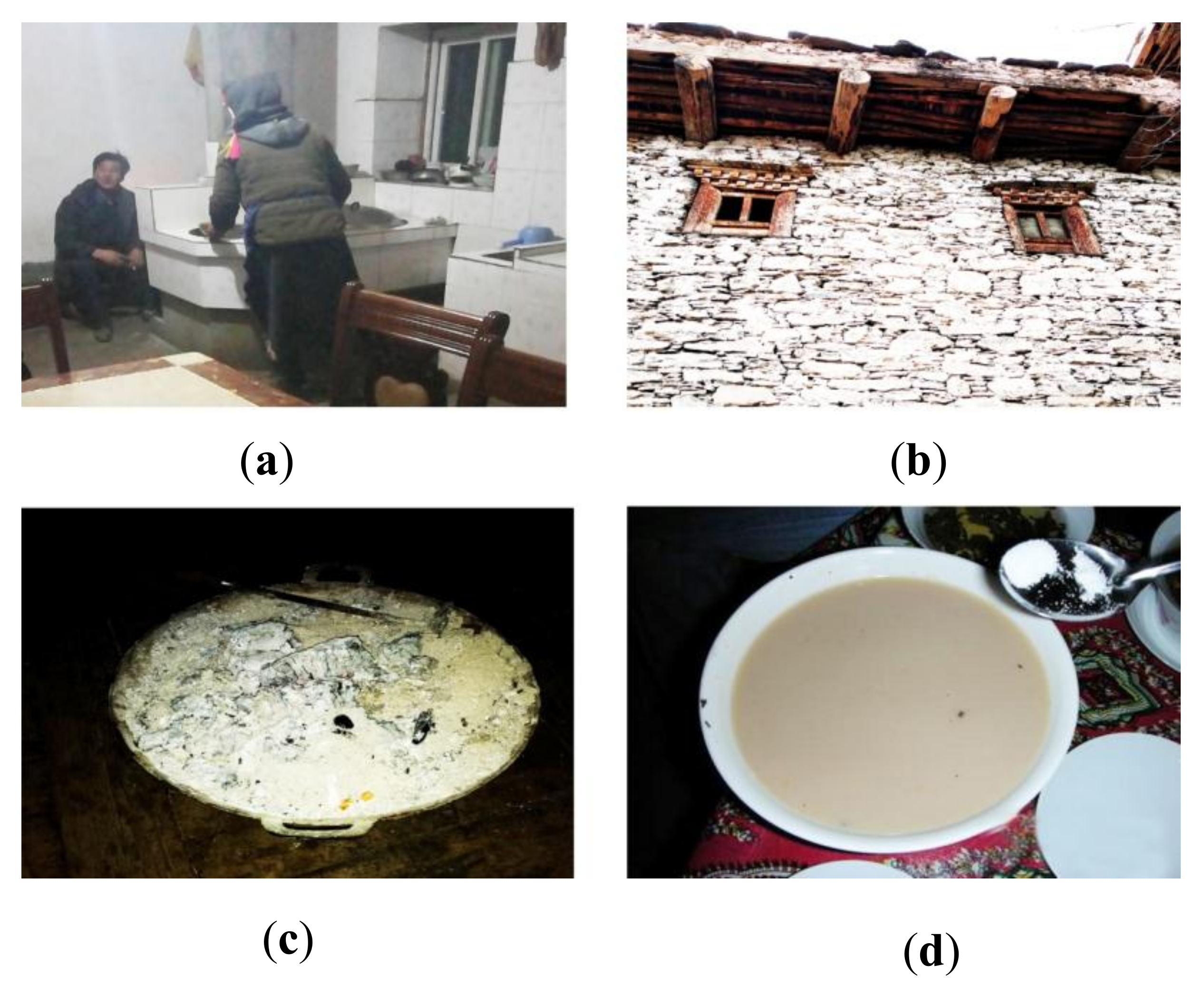

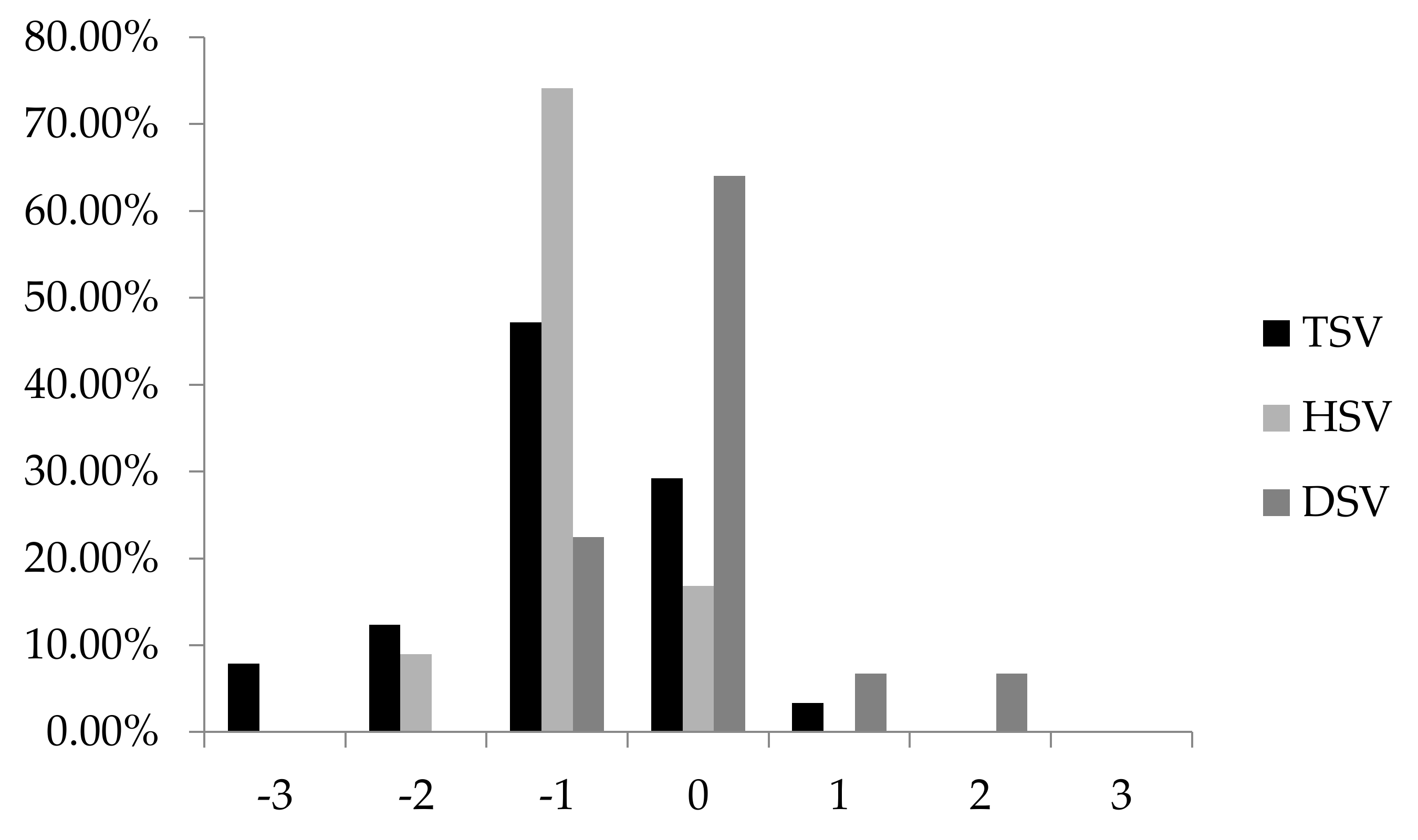
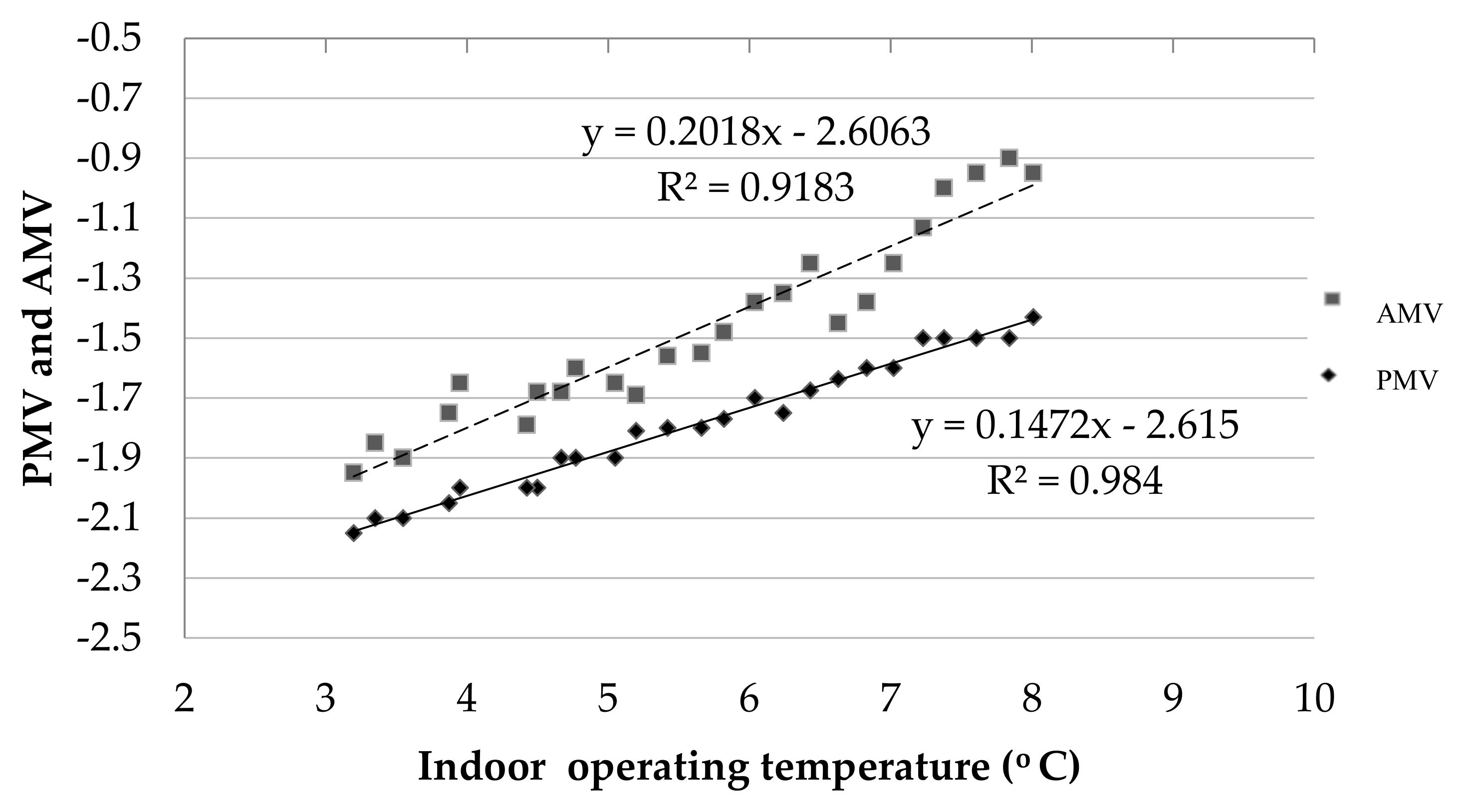
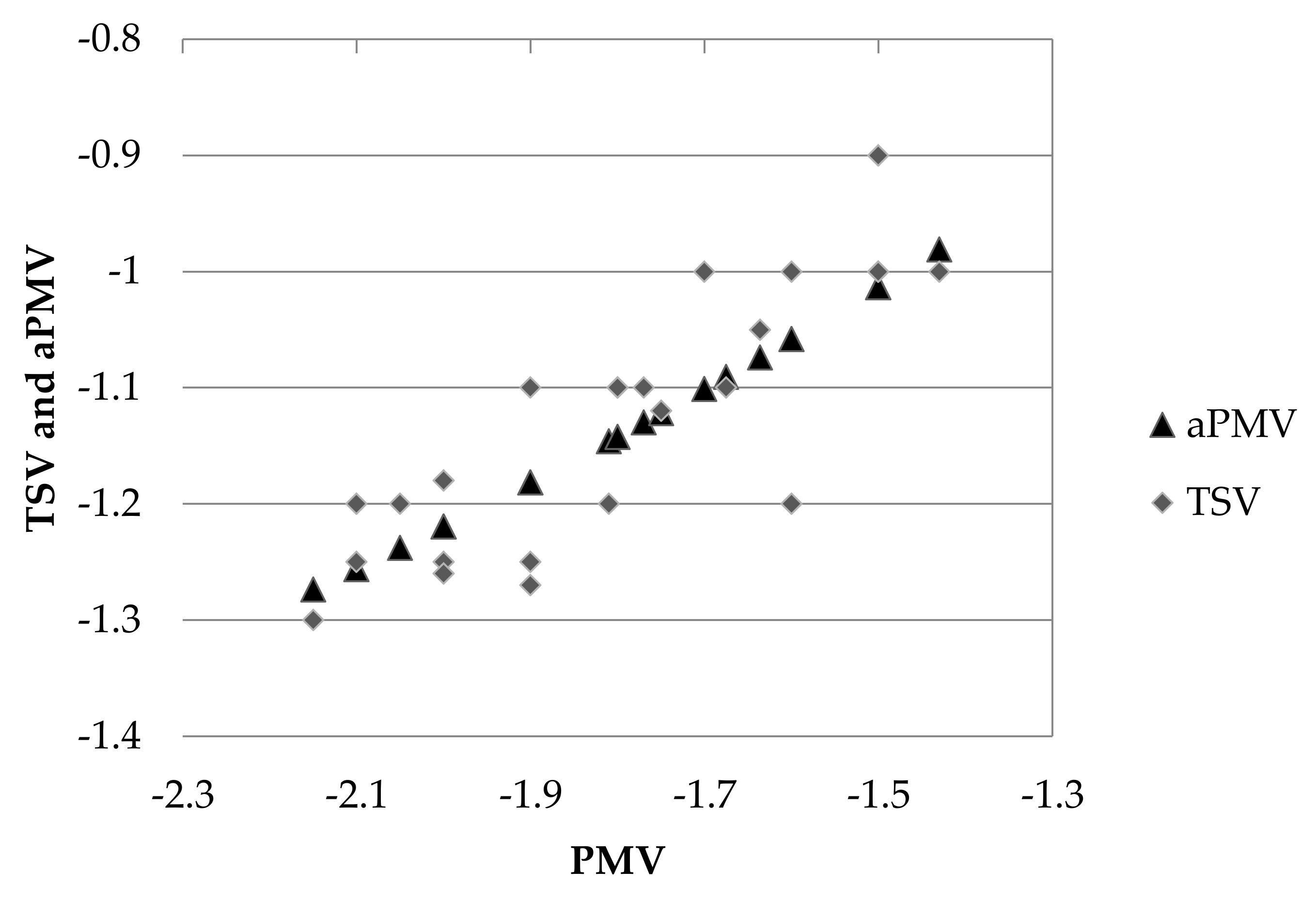
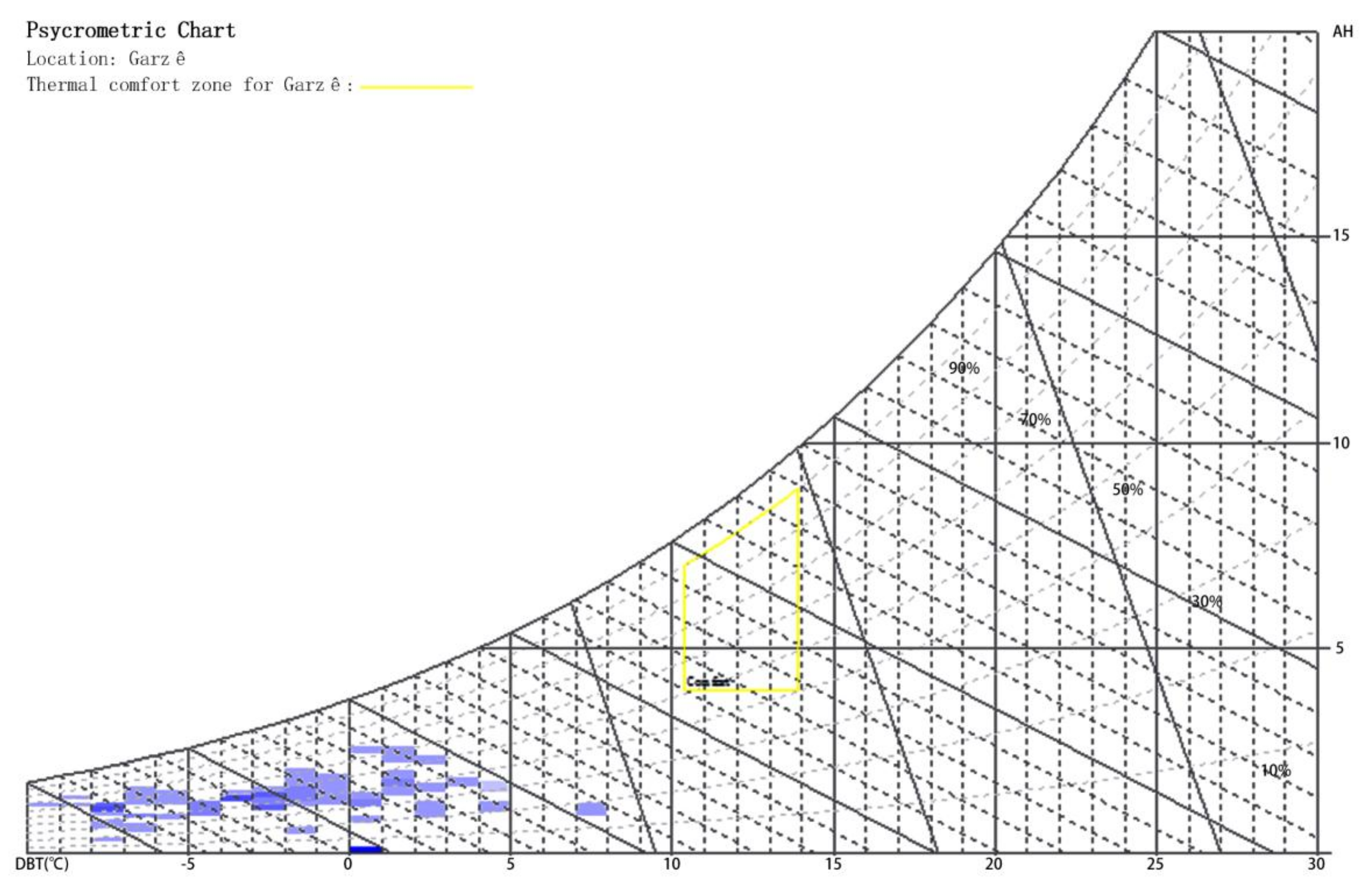
| County | North Latitude 1 | East Longitude 1 | Annual Average Air Temperature (°C) | Average Temperature of the Coldest Month (°C) | Average Temperature of the Hottest Month (°C) | Annual Average Sunshine Duration (h) | Annual Altitude (m) |
|---|---|---|---|---|---|---|---|
| Danba County | 30°52′ | 101°53′ | 14.2 | 4.4 | 22.4 | 2106.9 | 1800 |
| Heishui County | 32°03′ | 102°59′ | 9 | 5.4 | 10.9 | 2417 | 2350 |
| Mao County | 31°41′ | 103°51′ | 11.1 | 0.8 | 20.4 | 1549.4 | 1580 |
| Scale Points | Comfort Sensation | ||
|---|---|---|---|
| Temperature | Humidity | Air Velocity | |
| +3 | Hot | Very humid | Very still |
| +2 | Warm | Humid | Still |
| +1 | Slightly warm | Slightly humid | Slightly still |
| 0 | Neutral | Neutral | Neutral |
| −1 | Slightly cool | Slightly dry | Slightly breezy |
| −2 | Cool | Dry | Breezy |
| −3 | Cold | Very dry | Very breezy |
| Monitoring Parameters | Instrument/Sensor | Trade Name | Valid Range | Accuracy | Required Accuracy by Standards |
|---|---|---|---|---|---|
| Air temperature | Air Thermometer | JTR05 | −20~+120 °C | ±0.3 °C | ± 0.5 °C [14] |
| Globe temperature | Globe thermometer | JTSOFI-IAQ | −20~+50 °C | ±0.3 °C | ±0.4 °C [49] |
| Air velocity | Anemometer | JTSOFI-IAQ | 0.05~2 m/s | ±0.03 m/s | ±0.05 m/s [14] |
| Relative humidity (RH) | Hygrometer | Micro Log | 0~100% | ±2% | ±3% [49] |
| Sample | Type | Number (Percentage %) |
|---|---|---|
| Gender | Male | 138 (42%) |
| Female | 189 (58%) | |
| Total | 327 | |
| Age | 14–26 years | (58) 17.74% |
| 27–38 years | (65) 19.88% | |
| 39–51 years | (134) 40.98% | |
| 52–80 years | (70) 21.40% | |
| Average | 42 years |
| Classification | Prediction | Temperature (°C) |
|---|---|---|
| Average operating temperature (°C) | - | 6.29 |
| Neutral temperature (°C) | Forecast | 17.76 |
| Actual measurement | 12.92 |
© 2018 by the authors. Licensee MDPI, Basel, Switzerland. This article is an open access article distributed under the terms and conditions of the Creative Commons Attribution (CC BY) license (http://creativecommons.org/licenses/by/4.0/).
Share and Cite
Cheng, B.; Fu, Y.; Khoshbakht, M.; Duan, L.; Zhang, J.; Rashidian, S. Characteristics of Thermal Comfort Conditions in Cold Rural Areas of China: A Case study of Stone Dwellings in a Tibetan Village. Buildings 2018, 8, 49. https://doi.org/10.3390/buildings8040049
Cheng B, Fu Y, Khoshbakht M, Duan L, Zhang J, Rashidian S. Characteristics of Thermal Comfort Conditions in Cold Rural Areas of China: A Case study of Stone Dwellings in a Tibetan Village. Buildings. 2018; 8(4):49. https://doi.org/10.3390/buildings8040049
Chicago/Turabian StyleCheng, Bin, Yangliu Fu, Maryam Khoshbakht, Libin Duan, Jian Zhang, and Sara Rashidian. 2018. "Characteristics of Thermal Comfort Conditions in Cold Rural Areas of China: A Case study of Stone Dwellings in a Tibetan Village" Buildings 8, no. 4: 49. https://doi.org/10.3390/buildings8040049





